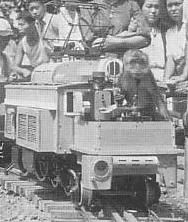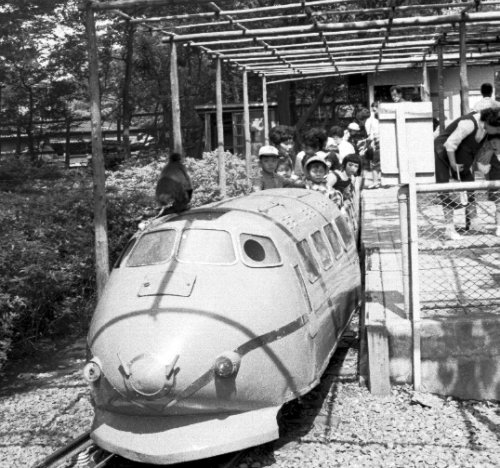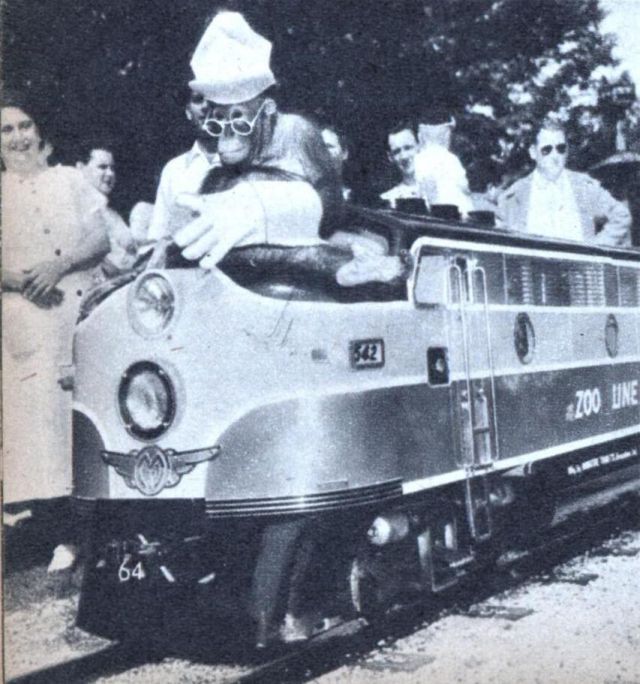
The monkey with the robot engineer. There appears to be a photo-electric cell mounted on the front. Maybe this is the 'robot' safeguard required for safe operation.

Jiro Aizawa was the inventor of the robotized "Monkey Train" at Tokyo's Ueno Zoo. Its been siad that he also patented the train, but I have not been able to locate that patent.
Children's Zoo and "Monkey Train"
Ueno Zoo also opened a children's zoo for the first time in Japan in April 1948. It also began the "Monkey Train" in October of the same year in order to attract visitors, given the paucity of popular animals among children. The Monkey Train, with a simian conductor carrying children in an open train, became an institution at the zoo (the handle was actually controlled electrically and was safe). Hayashi, the "idea man," designed this program and supervised the actions of the female crab-eating macaque as the conductor. This popular attraction continued until June 1974 when the zoo accepted criticisms, domestic and foreign, that chaining the crab-eating macaque to the train for over an hour, making it perform as a conductor, ran counter to the fundamental mandate of the Animal Protection and Control Law that Japan had legislated in 1973. At any rate, owing to Koga's leadership and Hayashi's creativity, Ueno Zoo recovered in 1951 almost to its wartime peak in 1940, registering 1,196 specimens of 232 species.'
Source: Far Eastern Economic Review, September 27, 1974– Page 13
Should monkeys drive trains?
Since 1948, happy trained monkeys have been regularly driving a three-car train around a 164-metre track inside Tokyo's Ueno Zoo, carrying an annual average of more than one million passengers, mostly children. They pull a lever, when the human station-master whistles, maintains an even speed with a hairy paw on the brakes, bring the train to a smooth halt at the end of the line, and spring out to salute the dismounting passengers. The working schedule for each monkey is less than two hours, with a union lay-off of two hours. The zoo authorities insist that the monkeys which are taught to drive are happier than caged monkeys, which jabber excitedly and point enviously as the train speeds by and the driver waves to them with tolerant superiority.
However, the Japan Animal Welfare Society (JAWS) rejoined the Japanese SPCA in protesting against the unique practice. A new Japanese law, JAWS says, demands that "animals should be handled in a proper manner with respect to the natural habits." Jiro Aizawa, chief director of the Japanese Children's Culture Research Institute, who invented and patented the monkey's train, opposes the animal lovers' campaign. "These adults", he argues logically, "must be persons who have never experienced the joys of playing with toys."
The new "Monkey Train" was based on the then new Bullet Train. The monkey was now only a "passenger".
December, 1971.

Due to public criticism, Ueon's "Monkey Train" was stopped in June of 1974.

Mechanix Illustrated, November 1950.
Ape Engineer Ling Wong is a baby orangutan at Lincoln Park Zoo, Chicago. Placidly wearing an engineer's cap, gloves and goggles, Ling squats on the Diesel engine of the "Zoo Line," the kids' own train, and it would be hard to say who's having the most fun. Ling used to work for the Chimpanzeelvania Line.